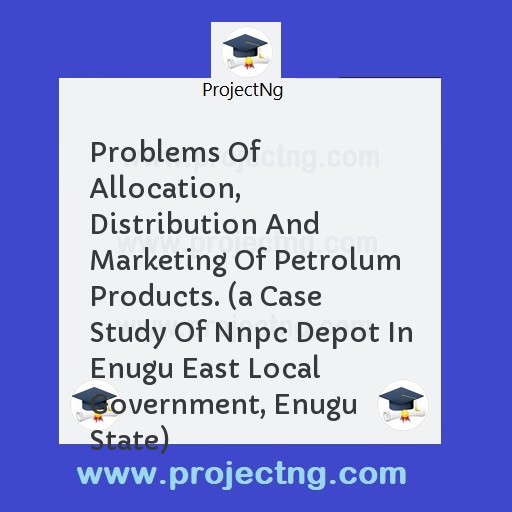Problems Of Allocation, Distribution And Marketing Of Petrolum Products. (a Case Study Of Nnpc Depot In Enugu East Local Government, Enugu State)
Business Administration Project Topics
Get the Complete Project Materials Now! »
PROBLEMS OF ALLOCATION, DISTRIBUTION AND MARKETING OF PETROLUM PRODUCTS. (A CASE STUDY OF NNPC DEPOT IN ENUGU EAST LOCAL GOVERNMENT, ENUGU STATE)
ABSTRACT
This research work has investigated the problems of allocation, distributed and marketing of petroleum products.
(A case study of NNPC Enugu Depot) which is located in Enugu East Local Government Area of Enugu State.
The major objective of this project or research work is to find out those problems that affect allocation/distribution and marketing of petroleum products at NNPC/PPMC depot Enugu.
To establish this, six research questions was used. From the findings the effective allocation pattern adopted by the management is strategically pattern and they have enough trained personnel’s for proper distribution of the products. Insufficiency of the petroleum products at the depot has always been a problem. Furthermore, inability to maintain and service procured equipment poses a threat to the industry. Poor condition of road net work affects the efficient distribution of the products. Adulteration of petroleum products poses a threat in the oil industry and on the users.
To ensure equitable distribution allocation and marketing of petroleum products, the management of NNPC/PPMC should ensure that product allocation to the marketers will be based on moral allocation formula.
And dismiss officers found wanting in the discharge of their duty. The federal government should allow more profit margin to markets. Rehabilitation of our roads is very important for effective distribution. Availability of the product at the depot is very important and government should see to that. The security agents see it as a duty to flush out touts to create a healthy atmosphere for marketers to operate.
Improvement on the poor condition of oil industry workers will go a great length in achieving the obligation of the industry.
These is favorably considered will induce workers to perform effectively and efficiency.
TABLE OF CONTENTS
Title page
Approval page
Dedication
Acknowledgement
Abstract
Table of content
CHAPTER ONE:
INTRODUCTION
1.1 Background of the study
1.2 Statement of problem
1.3 The purpose of the study
1.4 The scope of the study
1.5 Research problems
1.6 Significant of Terms
CHAPTER TWO
Review of Literature
CHAPTER THREE
METHODOLOGY
3.0 Research Design
3.1 Area of the study
3.2 Population for the study
3.3 Sample and sampling procedure
3.4 Instrument for data collection
3.5 Validity and reliability of the instrument
3.6 Method of collection
3.7 Method of data analysis
CHAPTER FOUR
DATA PRESENTATION AND ANALYSIS
CHAPTER FIVE
DISCUSSION, IMPLICATION AND RECOMMENDATIONS
5.0 Discussion of findings
5.1 Conclusions
5.2 Recommendations
5.3 Suggestions for further study
5.4 Limitation of the study
References
Appendix
LIST OF TABLE
Table 4.1; What are the allocation patterns adopted by the management?
Table 4.2 To what extent has lack of management skill and personnel lapses hinder the efficient allocation and distribution system at Enugu depot
Table 4.3 To what extent has the insufficiency of petroleum products at the depot affect distribution system?
Table 4.4 How far has the inability to maintain and service procured equipment pose a threat to the industry
Table 4.5 At what extent has poor condition of our roads network affect the efficient and effective distribution of petroleum product in Enugu zone?
Table 4.6 What are the impact of adulteration of petroleum product to the oil industry
CHAPTER ONE
INTRODUCTION
1.1 BACKGROUND OF THE STUDY
Oil exploration began in Nigeria in 1908 although the documentation of occurrence of the minerals were reported some five (5) years earlier in 1903. The exploration efforts were punctuated by two world wars but eventually yielded results with discovery of oil in Oloibiri in 1956 by sheel Bp. Bayeri (1996:7)
Production increased from a more five thousand (5,000) barrels per day in 1957 to seventeen thousands ( 17,000) per day by independence in 1960 and leapfrogged to four hundred and fifty thousand (450,000) barrels a per day by 1966. Although, this upgrade trend was slowed down by the civil war, by 1970 daily production had reduced the level of one million barrels per day. A peak production level of two million four hundred thousand (2.4 million) barrel per day was achieved during the second quarter of 1979.
However, before 1990 production fell to one million. Six hundred and eleven million (1.611 million) per day both on technical grounds and adherence to OPEC, quota brought about by the need to control production, to support price in a globally avert supplied to the market. As at (1999) OPEC quota for Nigeria stands at 1.865 million per day as set in 1990
The first marketing of oil from Nigeria occurred in 1958. DETEGE (1996:9). As most multinational oil comprise operating in the country has 100% equity in their operations up till 1973, there was no active government on Nigeria oil until then.
Prior to 1973, all Nigeria oil was marketed by oil producing comprise through integrated system using their transfer price. Government’s interest in the oil industry was handled by a number of government departments including the hydro carbon section in 1963 and department of petroleum in the ministry of mines and power in 1970. Although the Nigeria national petroleum corporation (NNPC) was formed in 1971 and was primarily to market Nigeria oil, government direct involvement in the marketing of oil did not begin until 1973. That was when the government started having it’s own equity interest in the operation of the oil companies ( Bayero 1996:10)
It has been the policy of government to put in place proper facilities in the down stream sector like refinery, distribution and marketing of petroleum products so as to embrace the value added to our petroleum resources. Presently, Nigeria has four refineries with two at Port Harcourt while Warri
Be the First to Share On Social

Enjoying our content?
Don't miss out on new videos! Subscribe to our YouTube channel for more awesome content.
Subscribe Now!













